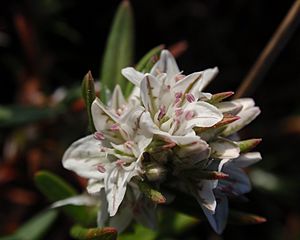Dune knotweed facts for kids
Quick facts for kids Dune knotweed |
|
|---|---|
 |
|
| Scientific classification | |
| Genus: |
Polygonum
|
| Species: |
paronychia
|
Polygonum paronychia is a cool flowering plant often called dune knotweed. You might also hear it called black knotweed or beach knotweed. It belongs to the knotweed family. This plant grows naturally along the coast of western North America. You can find it from British Columbia in Canada all the way down to California in the USA. It loves sandy places like beaches, sand dunes, and coastal scrub areas.
What is Dune Knotweed?
Dune knotweed is a small plant that can either lie flat on the ground or grow upright like a small bush. It has many brown stems that can grow up to about one meter (or 40 inches) long.
Sometimes, if a stem touches wet ground, it can grow new roots from that spot. This helps the plant spread!
Leaves and Stems
The leaves of the dune knotweed are placed one after another along the stems. However, you'll often see them grouped together near the ends of the branches.
The leaves are long and narrow, like a line or a spear tip. Their edges are often curled inwards. On the underside, they have a slightly rough middle vein.
Each leaf has a special part called a stipule. This stipule forms a wide, thin, papery sheath called an ochrea. This ochrea can be up to 2 centimeters (about 0.8 inches) long. It stays on the plant for a long time, even as it gets old and breaks into silvery, thread-like pieces.
Flowers
The flowers of the dune knotweed grow where the leaves meet the stem. This spot is called a leaf axil.
Each flower is small, only about one centimeter (0.4 inches) wide. It has five thin petals, which can be white or a light pink color.
How Was It Used?
In the past, people used this plant for a special purpose. They would make a soft, moist paste from it. This paste was called a poultice.
They applied this poultice to help treat skin infections, especially those on fingers or toes. These infections were sometimes called whitlows.

